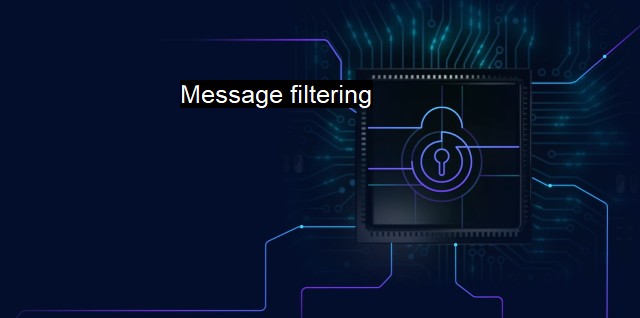What is Message filtering?
Secure Your Network: The Importance of Messaging Filtering in Protecting Against Cybersecurity Threats
Message filtering, in the context of cybersecurity and antivirus operations, refers to the practice of inspecting and managing data packets or messages passing through a network system with the purpose of eliminating any harmful, suspicious and undesirable elements that might threaten the integrity, security, and healthy functioning of the system or network.This core process of inspecting various kinds of electronic communication, which includes emails, application downloads, web content, and other forms of data exchange systems, is inspired by the objective of allowing or blocking access depending on the message's content. An intuitive instance of message filtering is the spam filter in our mailboxes, which separates irrelevant, redundant, and potentially harmful emails from the struggle for our attention.
Message filtering gains its relevance from the surging threats of cybersecurity breaches and data thefts across the globe. With internet usage being at prolific heights and internet-based activities taking precedence over daily chores, constant digital interaction has become the norm, making the necessity for a line of cybersecurity stringencies such as message filtering crucial.
Cybercriminals with nefarious intentions often use data packets as their tools for intrusion. Without filtering, these data packets could easily make their way into a network and lead to potential breaches. Hence, the act of message filtering effectively divides the incoming network traffic into two components: the legitimate flow of information that aids users and the illegitimate flow, which poses threats to the system.
In layman's terms, it is the act of sifting through tons of messages coming to a network to pick up the ones having potential threats. It involves the significant use of algorithms and complex codes, which enable the filtering systems to read, understand, and bifurcate the messages based on their potential harm or benefit.
Antivirus programs play a significant role in implementing and enhancing filtering mechanisms. Equipped with predefined algorithms, antiviruses scan every incoming message for threats and contain them at entry points itself. The algorithms primarily focus on the suspicious patterns in the data packets, which could carry potent threats to the system. These patterns could be signatures of known malware, abnormal behavior tracing back to anomalies, or simply unexpected fluctuations and variations in the data packets.
The process of filtering and judging a message to be safe or a threat isn't exhaustive or exclusive. Traditionally, filtering for known patterns was carried out. due to the evolving nature of cyber threats and the introduction of multifaceted, adaptive malware, the message filtering process sees continuous modifications and advancements. It now uses both heuristic and sandboxing techniques to not just filter against the known but also predict and safeguard the system against unknown or unrecognized hazards.
The process of message filtering in cybersecurity demonstrates a meticulous back-and-forth - it acts as an active supporter of antivirus functions, and in turn, the success of antivirus operations strengthens the filtering mechanism.
Message filtering is an integral part of cybersecurity and antivirus defense. To behold the immense complexity of data exchange systems and the security implications of the vast nature of internet communications requires a robust, dynamic continuation of these filtering processes. Through accurate, intuitive filtering, we can establish a safe, reliable network environment devoid of the constant threats of cyber attacks. It equips internet users with better, more secured digital interactions, directly promoting an increased peace of mind amidst the cyber whirls. The fact that effective filtering not only wards off known threats but also uncovers an unidentified hazard compels us to appreciate the significance of this key line of cybersecurity defense.

Message filtering FAQs
What is message filtering and how does it work?
Message filtering is a process used in cybersecurity and antivirus software that examines incoming messages, such as emails and text messages, for certain patterns or content. These filters are designed to catch and block messages that contain malicious code, phishing attempts, or other threats.Why is message filtering important in cybersecurity?
Message filtering is important in cybersecurity because it helps prevent malicious messages from reaching computer systems and networks. Malicious messages can contain viruses, malware, ransomware, and other types of threats that can compromise system security and lead to data breaches.What are some common types of message filtering techniques?
There are several techniques used in message filtering, including content filtering, signature-based filtering, and heuristics-based filtering. Content filtering looks for specific words or patterns in messages, while signature-based filtering uses a database of known malware signatures to identify and block malicious messages. Heuristics-based filtering uses algorithms to analyze messages and determine whether they are likely to be malicious.Can message filtering be bypassed by cybercriminals?
While message filtering is an effective tool in cybersecurity, it is not foolproof. Cybercriminals can use various tactics, such as encryption or obfuscation, to try to bypass message filters. In addition, some attacks may use social engineering or other non-technical means to trick users into opening malicious messages. Therefore, it's important to have multiple layers of security in place, including regular software updates and employee training on cybersecurity best practices.| | A | | | B | | | C | | | D | | | E | | | F | | | G | | | H | | | I | | | J | | | K | | | L | | | M | |
| | N | | | O | | | P | | | Q | | | R | | | S | | | T | | | U | | | V | | | W | | | X | | | Y | | | Z | |
| | 1 | | | 2 | | | 3 | | | 4 | | | 7 | | | 8 | | |||||||